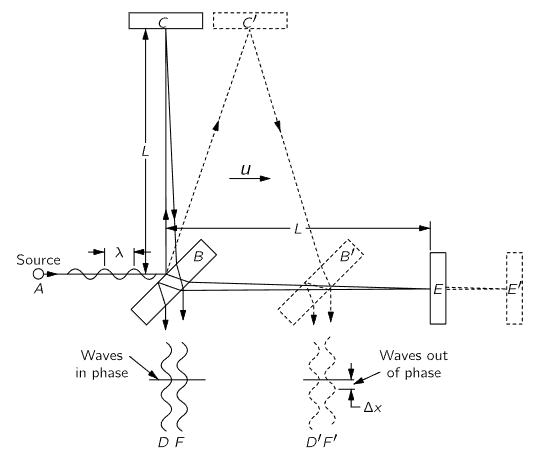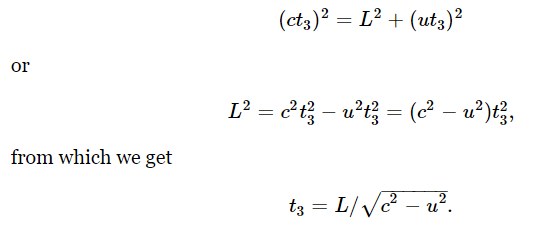
The Michelson-Morley experiment
 المؤلف:
Richard Feynman, Robert Leighton and Matthew Sands
المؤلف:
Richard Feynman, Robert Leighton and Matthew Sands
 المصدر:
The Feynman Lectures on Physics
المصدر:
The Feynman Lectures on Physics
 الجزء والصفحة:
Volume I, Chapter 15
الجزء والصفحة:
Volume I, Chapter 15
 2024-02-24
2024-02-24
 2320
2320
As mentioned above, attempts were made to determine the absolute velocity of the earth through the hypothetical “ether” that was supposed to pervade all space. The most famous of these experiments is one performed by Michelson and Morley in 1887. It was 18 years later before the negative results of the experiment were finally explained, by Einstein.

Fig. 15–2. Schematic diagram of the Michelson-Morley experiment.
The Michelson-Morley experiment was performed with an apparatus like that shown schematically in Fig. 15–2. This apparatus is essentially comprised of a light source A, a partially silvered glass plate B, and two mirrors C and E, all mounted on a rigid base. The mirrors are placed at equal distances L from B. The plate B splits an oncoming beam of light, and the two resulting beams continue in mutually perpendicular directions to the mirrors, where they are reflected back to B. On arriving back at B, the two beams are recombined as two superposed beams, D and F. If the time taken for the light to go from B to E and back is the same as the time from B to C and back, the emerging beams D and F will be in phase and will reinforce each other, but if the two times differ slightly, the beams will be slightly out of phase and interference will result. If the apparatus is “at rest” in the ether, the times should be precisely equal, but if it is moving toward the right with a velocity u, there should be a difference in the times. Let us see why.
First, let us calculate the time required for the light to go from B to E and back. Let us say that the time for light to go from plate B to mirror E is t1, and the time for the return is t2. Now, while the light is on its way from B to the mirror, the apparatus moves a distance ut1, so the light must traverse a distance L+ut1, at the speed c. We can also express this distance as ct1, so we have

(This result is also obvious from the point of view that the velocity of light relative to the apparatus is c−u, so the time is the length L divided by c−u.) In a like manner, the time t2 can be calculated. During this time the plate B advances a distance ut2, so the return distance of the light is L−ut2. Then we have

Our second calculation will be of the time t3 for the light to go from B to the mirror C. As before, during time t3 the mirror C moves to the right a distance ut3 to the position C′; in the same time, the light travels a distance ct3 along the hypotenuse of a triangle, which is BC′. For this right triangle we have

For the return trip from C′ the distance is the same, as can be seen from the symmetry of the figure; therefore, the return time is also the same, and the total time is 2t3. With a little rearrangement of the form, we can write

We are now able to compare the times taken by the two beams of light. In expressions (15.4) and (15.5) the numerators are identical, and represent the time that would be taken if the apparatus were at rest. In the denominators, the term u2/c2 will be small, unless u is comparable in size to c. The denominators represent the modifications in the times caused by the motion of the apparatus. And behold, these modifications are not the same—the time to go to C and back is a little less than the time to E and back, even though the mirrors are equidistant from B, and all we have to do is to measure that difference with precision.
Here a minor technical point arises—suppose the two lengths L are not exactly equal? In fact, we surely cannot make them exactly equal. In that case we simply turn the apparatus 90 degrees, so that BC is in the line of motion and BE is perpendicular to the motion. Any small difference in length then becomes unimportant, and what we look for is a shift in the interference fringes when we rotate the apparatus.
In carrying out the experiment, Michelson and Morley oriented the apparatus so that the line BE was nearly parallel to the earth’s motion in its orbit (at certain times of the day and night). This orbital speed is about 18 miles per second, and any “ether drift” should be at least that much at some time of the day or night and at some time during the year. The apparatus was amply sensitive to observe such an effect, but no time difference was found—the velocity of the earth through the ether could not be detected. The result of the experiment was null.
The result of the Michelson-Morley experiment was very puzzling and most disturbing. The first fruitful idea for finding a way out of the impasse came from Lorentz. He suggested that material bodies contract when they are moving, and that this foreshortening is only in the direction of the motion, and also, that if the length is L0 when a body is at rest, then when it moves with speed u parallel to its length, the new length, which we call L∥ (L-parallel), is given by

When this modification is applied to the Michelson-Morley interferometer apparatus the distance from B to C does not change, but the distance from B to E is shortened to  . Therefore Eq. (15.5) is not changed, but the L of Eq. (15.4) must be changed in accordance with Eq. (15.6). When this is done, we obtain
. Therefore Eq. (15.5) is not changed, but the L of Eq. (15.4) must be changed in accordance with Eq. (15.6). When this is done, we obtain

Comparing this result with Eq. (15.5), we see that t1+t2=2t3. So, if the apparatus shrinks in the manner just described, we have a way of understanding why the Michelson-Morley experiment gives no effect at all. Although the contraction hypothesis successfully accounted for the negative result of the experiment, it was open to the objection that it was invented for the express purpose of explaining away the difficulty, and was too artificial. However, in many other experiments to discover an ether wind, similar difficulties arose, until it appeared that nature was in a “conspiracy” to thwart man by introducing some new phenomenon to undo every phenomenon that he thought would permit a measurement of u.
It was ultimately recognized, as Poincaré pointed out, that a complete conspiracy is itself a law of nature! Poincaré then proposed that there is such a law of nature, that it is not possible to discover an ether wind by any experiment; that is, there is no way to determine an absolute velocity.
 الاكثر قراءة في النظرية النسبية الخاصة
الاكثر قراءة في النظرية النسبية الخاصة
 اخر الاخبار
اخر الاخبار
اخبار العتبة العباسية المقدسة


